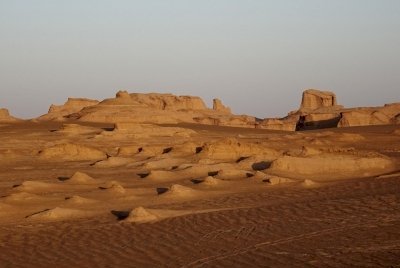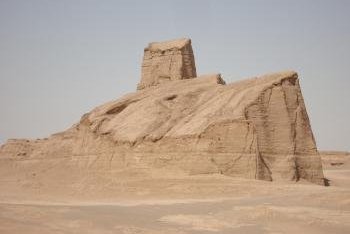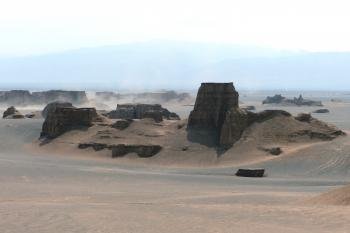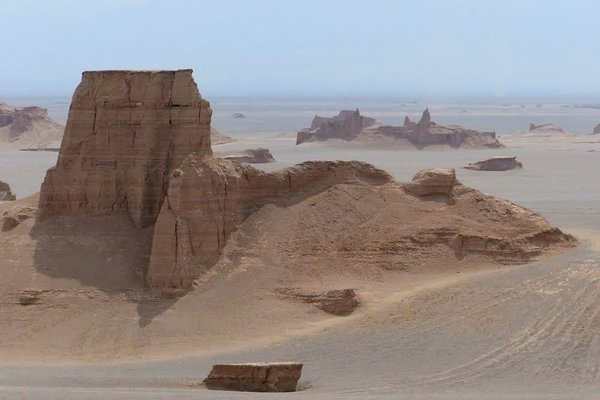Iran
Lut Desert
The Lut Desert comprises a hot desert landscape containing spectacular landforms shaped by wind erosion.
The visually stunning landscape has a mosaic of desert colours and a mix of high sand dunes, nebkha dune fields and yardangs, mushroom rock-like features where the soft material has eroded from. Its salt desert is known as one of the hottest places on earth and displays a variety of salt landforms such as salt pans, gypsum domes and salt pingos.
Community Perspective: It’s a huge desert so which part to visit? Jarek and Solivagant both went to areas just beyond Shahdad, were successful in seeing Nebkhas and Yardangs and experienced the heat.
Site Info
Official Information
- Full Name
- Lut Desert (ID: 1505)
- Country
- Iran
- Status
-
Inscribed 2016
Site history
History of Lut Desert
- 2016: Advisory Body overruled
- IUCN asked for a Referral
- 2016: Inscribed
- Inscribed
- Type
- Natural
- Criteria
- vii
- viii
Links
- UNESCO
- whc.unesco.org
- Official
-
- visitiran.ir — Visit Iran
All Links
UNESCO.org
- whc.unesco.org — whc.unesco.org/
Official Website
- visitiran.ir — Visit Iran
News Article
- Oct. 12, 2021 tehrantimes.com — 'World’s largest' nabkha discovered in UNESCO-tagged Lut Desert
- Sept. 27, 2020 techzle.com — Freshwater crabs in the hottest place on earth
- Aug. 7, 2019 tehrantimes.com — Lut Desert draws 5,000 foreign visitors a year
- Aug. 9, 2018 tehrantimes.com — Lut Desert’s World Heritage base renovated
- Nov. 4, 2017 financialtribune.com — Unlicensed Tours to Lut Desert Banned
Community Information
- Community Category
- Natural landscape: Desert
Travel Information
Red Zone Travel Advisory
Recent Connections
-
Red Zone Travel Advisory
Iran fully off-limits -
Kerman Hotspot
-
Late Pleistocene
Aridity and geomorphological features d…
Connections of Lut Desert
- Individual People
-
-
Sir Wilfred Thesiger
1964See prmprints.com
-
- Ecology
-
-
Badlands
"Other dry-land landforms include ... gullied badlands and alluvial fans (bajada)." (OUV) -
Dunes
-
Gypsum
gypsum domes (OUV) -
Salt Flats
Various salt features are found over about 4% of the nominated area, especially in the playa of Shurgaz-e Hamun (AB ev) -
Yardangs
"the area possesses what are considered the world’s best examples of aeolian yardang landforms" (OUV Brief synthesis) -
Extreme temperatures
The region often experiences Earth’s highest land surface temperatures: a temperature of 70.7°C has been recorded within the property. (source: short description UNESCO website) -
Ergs
".... 6 - Star Dunes With Cresentic Ridge (Central Erg), ......8 - Linear Dunes With Silk and Chaotic Dunes and Some Outcrop of Lut Formation (Southern Erg) ...." . From list of inscribed areas in Nom File -
Hyper-arid
"The property is situated in an interior basin surrounded by mountains, so it is in a rain shadow and, coupled with high temperatures, the climate is hyper-arid." (OUV)
-
- WHS on Other Lists
-
-
IUGS Geological Heritage Sites
Yardang (Kalut) in the Lut Desert
-
- Timeline
-
-
Late Pleistocene
Aridity and geomorphological features date from the Late Quaternary, so Late Pleistocene at its earliest
-
- WHS Hotspots
- Visiting conditions
-
-
Red Zone Travel Advisory
Iran fully off-limits
-
News
- tehrantimes.com 10/12/2021
- 'World’s largest' nabkha discovere…
- techzle.com 09/27/2020
- Freshwater crabs in the hottest pl…
- tehrantimes.com 08/07/2019
- Lut Desert draws 5,000 foreign vis…
Recent Visitors
Visitors of Lut Desert
- Afshin Iranpour
- Alexander Parsons
- Ask Gudmundsen
- Atila Ege
- DouglasR
- Erik Jelinek
- fedemarch92
- Fmaiolo@yahoo.com
- George Gdanski
- Ivan Rucek
- Jacob Otten
- Jarek Pokrzywnicki
- Javier
- Jean Lecaillon
- Malgorzata Kopczynska
- Martina Rúčková
- MaYumin
- Nihal Ege
- Roman Bruehwiler
- Solivagant
- Szucs Tamas
- Thomas Buechler
- Wojciech Fedoruk
- Zizmondka
- Zoë Sheng
Community Reviews
Show full reviews
Low in beautiful landscapes, Lut Desert is the exception that proves the rule in Iran. It is known like the hottest place in the world, but frankly speaking, it was nice when i've been there (november 2016). This desert is awesome and rare, it is not an erg or reg, it is a blend of earth and dust. Very special but incredible. The must-see is the light during the sunset, so enjoyable.
In France, our Ministry of Foreign Affairs advises us where we can go and where we should not go thanks to a scale of values: in particular a map with colours, green when it's ok, red when it's not (yellow and orange between green and red). I guess it's more or less similar in other countries (western countries at least). Today, Iran is totally in red for political reasons (especially today it's understandable because of protests and the death of Mahsa Amini, but it was not so obvious before). It was not the case in november of 2016, but Lut Desert and almost all the borders of Iran were coloured in red. The invoked reason was mainly presence of anti-personnel mines. As you can't go there alone, this reason seemed not so relevant to me, i wouldn't say the same in case of wars or dangerous diseases (Ebola for example). So I've been there and i don't regret it.
If my memory is good, I was in Kerman and my friends and me took a taxi …
Keep reading 0 comments
Just visited - May 2010. Main question about this place is the limits of inscribed site. Dispite relatively huge area the place is not protected as a National Park or reserve, it is just a dessert. But while studying the official map on UNESCO website I am pretty sure that Nebkas area (just outside Shahdad) and Kaluts (some 40 km from Shahdad) are part of World Heritage.
In fact on the right side of the road Kerman - Zabol, just outside Shahdad (around one km from the town) there is a small brown sign - Nominated Area, probably marking the limits of Lut Desert as a World Heritage Site. That should include Nebkas area as well. Further on, while you enter Kaluts, there is just a small sign although the road just crosses sandstone castles.
Some practicalities: I read there is a public transport to Shahdad (but not to Kaluts) but the most convenient way is to rent a car (taxi) which I did. I took a car from Mahan to Shahdad than to Kaluts and return to Kerman for 1.200.000 Rial (including waiting time in the Kaluts area). It may take half to full day depending on the time you want to spend in Kaluts. I am pretty sure that similar can be organised from Kerman.
Take plenty of water with you as it is the hottest place on earth, and something to cover a head. In fact descend from mountains to Shahdad was like going …
Keep reading 0 comments
Two problems with trying to get “ahead of the game” by visiting T List sites before they are inscribed are that they might fail and also that any inscribed boundaries are as yet unknown/undetermined!! Iran has titled this site “Lut Desert (Vicinity of Shahdad)” and nominated it for consideration in 2016. Well, as the desert itself is 5400 km2 in area and is the 25th largest desert in the World (Wiki), I suppose we had to be thankful that we had been given some sort of starting point!!
Shahdad lies around 95kms NE of Kerman and the entire trip by car into the Lut and back from Kerman took best part of an afternoon after seeing the fine Sufi shrine at nearby Mahan. The road was far better than I had expected from my map and it even cut through the mountains north of Kerman in a long tunnel before dropping down, down into the Lut at Shahdad. From there it wends its way for another c500kms across the desert to the town of Zabol on the Afghan border. Beyond Shahdad, ours was the only car but the well surfaced road carried a steady stream of lorries. I tried to forget that Shahr-i-Sokhtar was only 50kms south of Zabol - just a day’s journey away. But, “there lies madness” when chasing WHS - there will always be another just beyond the planned route!
Among the 4 “world records” claimed for Lut by Iran in its T List introduction is one …
Keep reading 0 comments
